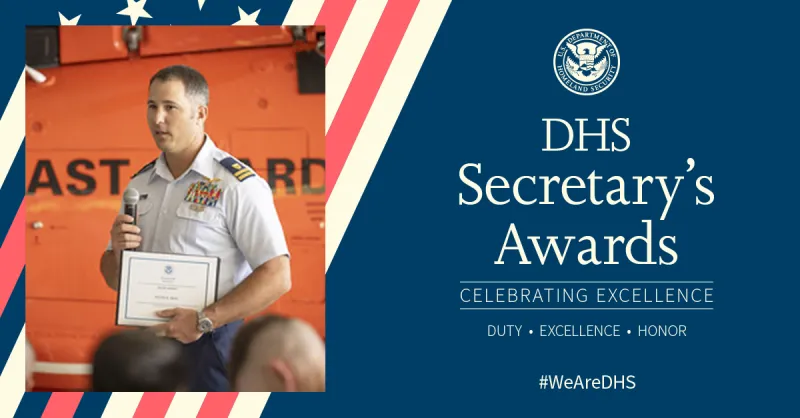
Lt. Justin Neal, a pilot previously assigned to the Coast Guard Air Station Sitka’s MH-60 Jayhawk helicopter crew, received the Department of Homeland Security’s (DHS) Secretary’s award for Valor during the Department’s Southeastern Regional Secretary’s Awards Ceremony, April 13, 2022.
Three of his fellow crewmembers – Lt. Jonathan Orthman, AET2 Jimmy Schwader and AST2 Grant Roberts – will also receive the Secretary’s award for Valor for their heroic actions while rescuing a 70-year-old fishing vessel owner and operator from stormy seas. Watch the video of the rescue.
“The wind was shaking the house before I left for duty that evening,” Neal told Secretary Mayorkas during the ceremony. “It was one of those nights when you go on duty where you’re like, ‘If I have to go out tonight it’s going to be challenging.’ Within about an hour of coming on duty we got the call.”
At 5:30 p.m. on November 1, 2020, an alarm sounded at Coast Guard Air Station Sitka, Alaska. An Emergency Position-Indicating Radio Beacon (EPIRB) registered to fishing vessel Irony had been activated in Earnest Sound, 150 miles southeast of Sitka. The crew departed the air station as a low-pressure storm system battered Southeast Alaska. Read the full story by the U.S. Coast Guard.
“When we get an EPIRB signal, nine out of ten times someone needs help,” said Neal, a California native. “The minimum requirements were met to take the case. The question was not. would we go fly, it was, how are we going to safely get there.”
This wasn’t a typical rescue scenario. It was dark. 70 mph headwinds offshore reduced the speed at which they could reach the survivor. Zero visibility forced the team to navigate 265-miles around rugged terrain. There was no straight path to the man who was stranded in the water clinging to a piece of debris from his sunken boat.

“This was by far the most challenging weather conditions I have flown in during my 16 year/ 4,000+ flight hour career,” said Neal, who spent eight years in the Army before joining the Coast Guard eight years ago. “It was a two plus hour transient in 60 plus knot winds, with zero visibility and severe turbulence as we navigated through the narrow waterways of Southeast Alaska. I am very thankful for having the opportunity to be there to help that gentleman out, but I would much prefer to not have to fly in those conditions again.”
After more than two hours of travel, the crew kept an eye on their fuel levels as they reached the general vicinity of the downed ship. They knew they only had about 25 to 30 minutes on the scene to look for any survivors before they would need to leave and get more fuel. And as can be expected, the low visibility of the night made it difficult to locate the survivor in the water.
“We knew the general location of where survivors may be,” Neal said. “We approached the beacon but no one was near it. We were actually 300 or 400 yards ahead of him. We used the helicopter’s infrared camera to locate him in the water.”
Rescue swimmer, AST2 Grant Roberts, was deployed into the water upwind of the debris. Swimming through the 10-12 foot seas and the debris from the ship, he was able to reach the gentleman. The 70-year-old and Roberts were successfully hoisted into the helicopter together.
According to Neal, a lot of things are being evaluated and adjusted when the rescue swimmer is in the water. Are we dropping the swimmer in the right spot? Can the rescue swimmer reach the person who needs to be rescued? How can we help reposition him if he loses track of the survivor? How are we going to get them out of the water?
“Roberts had difficulty locating the survivor once he was in the water due to the high sea state,” explained Neal. “We had to use the aircraft spotlight to help direct him to the location of the survivor.”
After rescuing the survivor the crew still had to fly to Ketchikan to transfer the survivor to awaiting EMS. An added layer of complexity to this rescue was the city-wide power outage in Ketchikan. This absence of cultural lighting mixed with the low visibility and extreme darkness due to the rain and thick cloud cover made it difficult to see the helipad. Approaching the dark shoreline, the crew relied on the lights of the ambulance that was waiting to transport the survivor to the hospital, to safely land the helicopter on the small, dark helipad.
“What a team effort that we were able to put together to include District 17 Command Center and Sector Juneau,” said Neal. “the Sector watchstanders kept updating us on the position of the vessel. It wasn’t until we landed in Ketchikan, three and a half hours later, I was like ‘wow, what did we just do?’
Neal was transferred to Coast Guard Air Station Borinquen, Puerto Rico, May 2021, where he serves as the Assistant Engineering Officer, but he still thinks about this particular rescue.
“It’s been a while since it happened,” he said. “but it’s one of those cases that you will never forget, you’ll always remember, and you hope never have to repeat.”
Visit the Recognizing DHS Excellence page for more stories about this year’s awardees.
